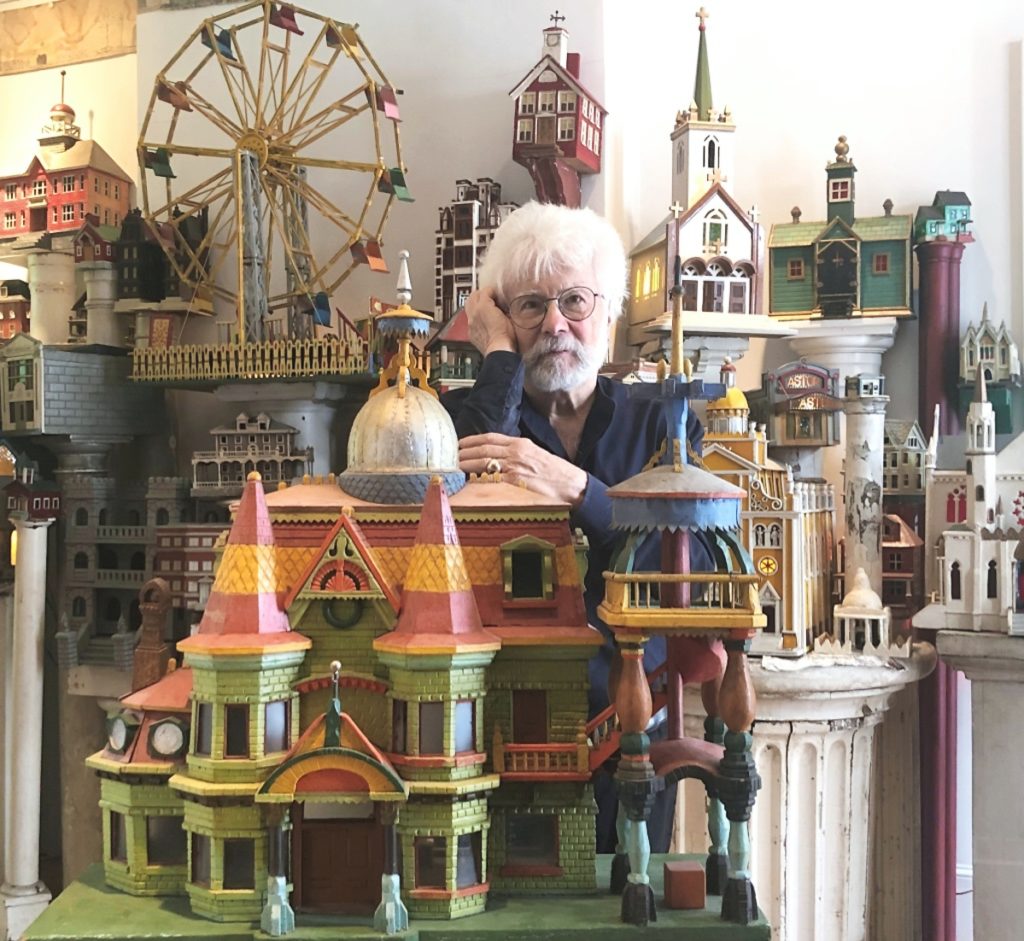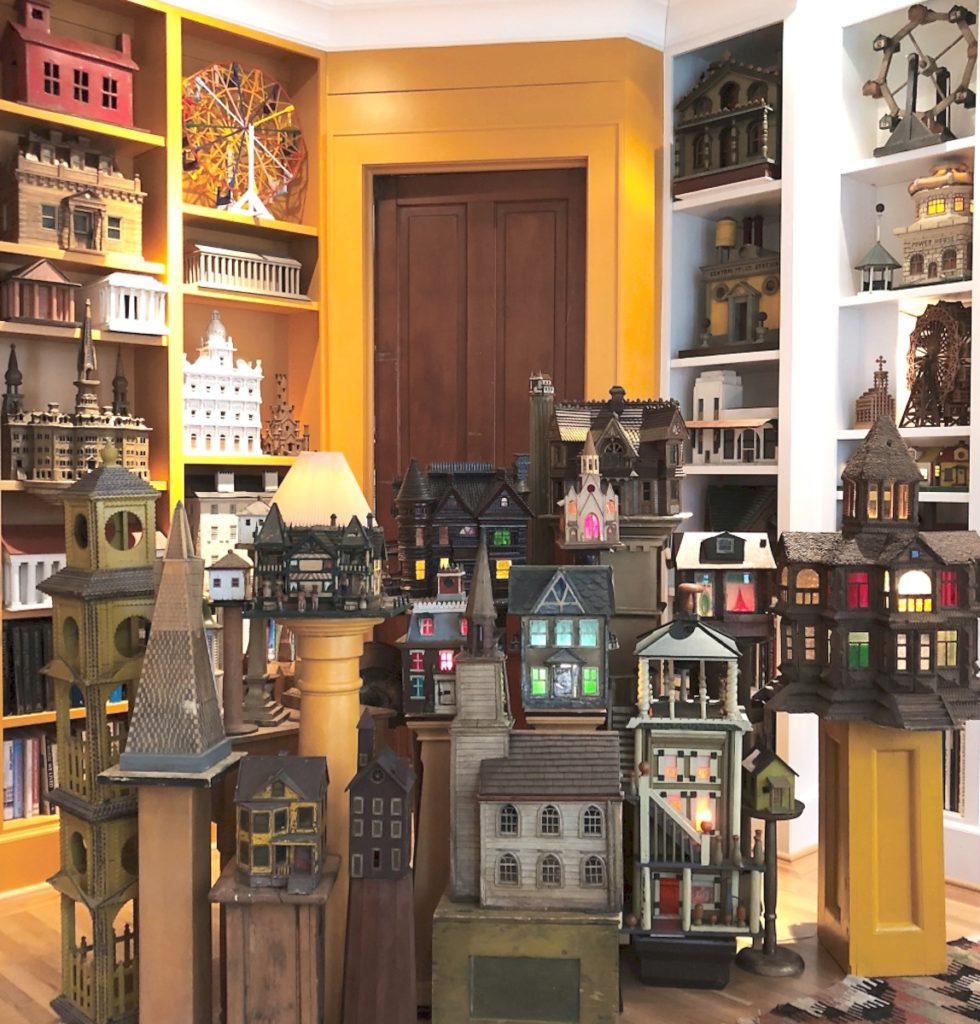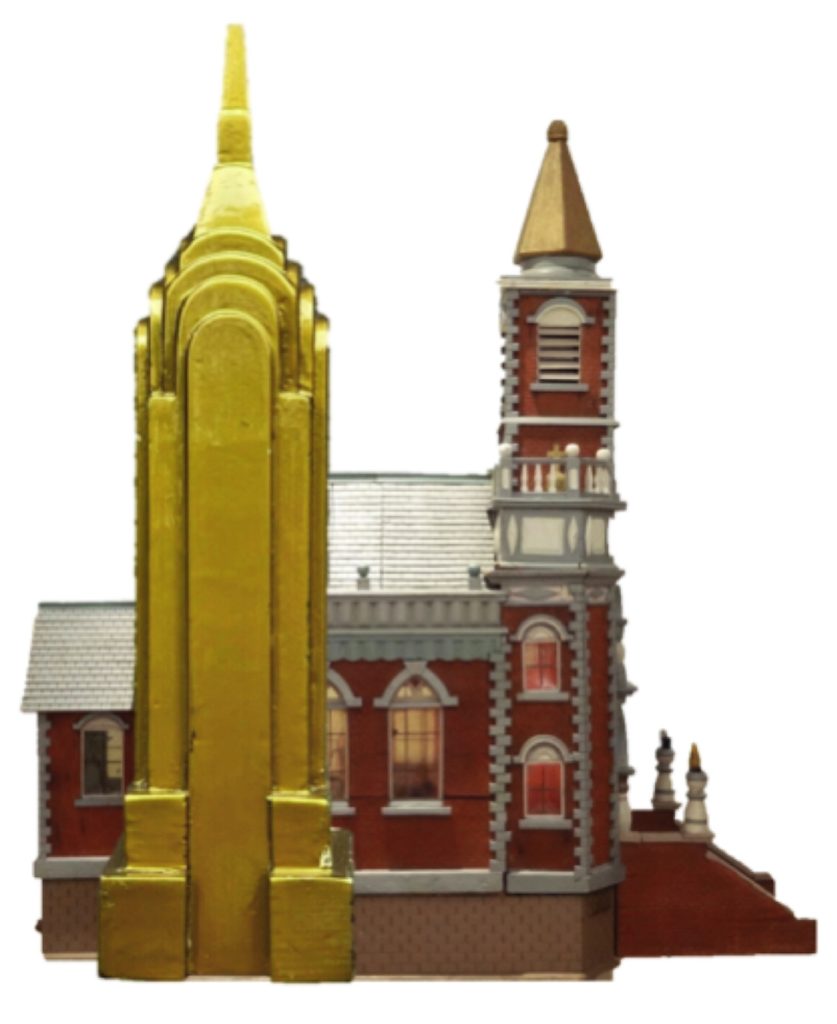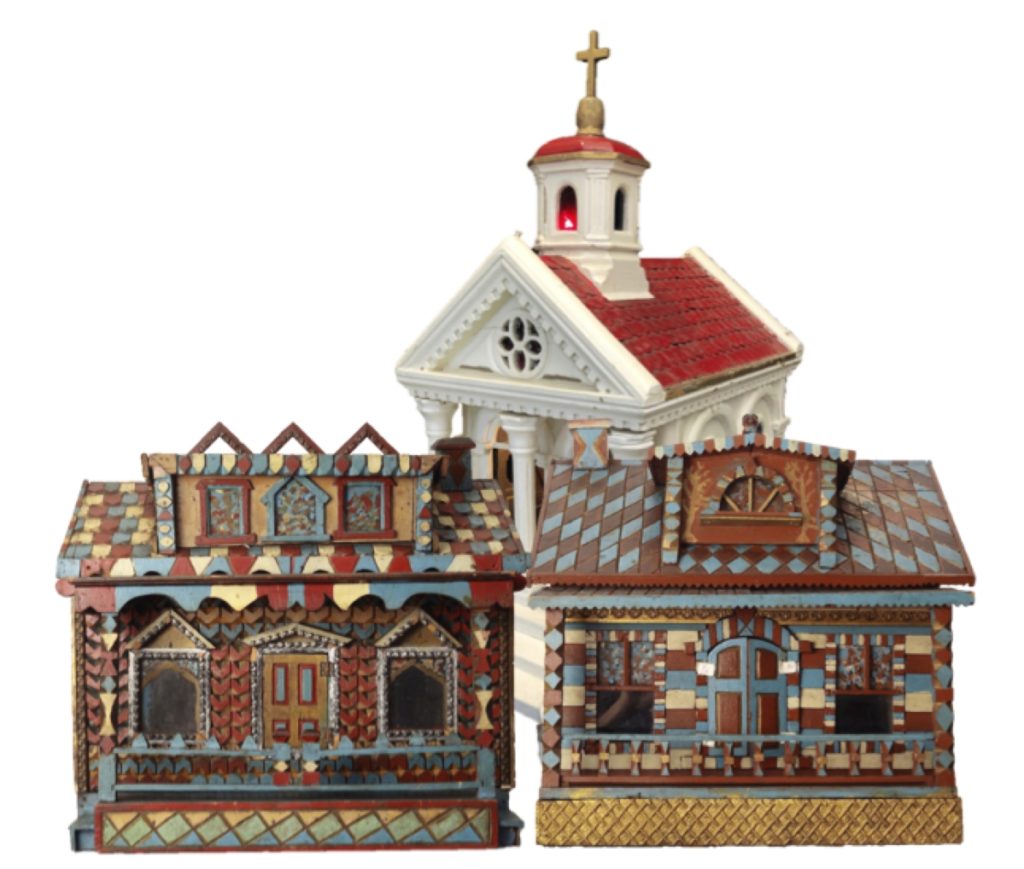
The son of a senior army officer and diplomat, Steven Burke grew up around the world, “long happily attending” in his words to buildings, initially large but also, small ones as of 1985. A North Carolina resident since 1966, when he arrived at Duke to gain a degree in Religion & Literature, followed by an MEd in Instructional Design and five years on the faculty of North Carolina State University in Raleigh. He followed a 28-year career in state, national and international biotechnology development. He and his husband, Randy Campbell, found American folk art buildings an engaging balance to work and, in retirement, a compelling endeavor. When word of this collection reached our ears, we reached out to Burke for what drove his passion, what these buildings say about the people who made them and the culture in which they were made.
You’re compelled by what you call American Folk Art Buildings. Introduce us to your collection and this architecture.
Americans have wonderfully rendered small the buildings of real or imagined communities, from mostly late Nineteenth until mid-Twentieth Century. Did we know they created so many as well as a revelatory expression of American material culture?
Not dollhouses, birdhouses or architects’ models, the buildings shape other needs and pleasures. Makers were not fine or professional artists, but they could make things – from imagination, from what they saw or lived or loved, from at-hand materials and in-hand skill.
Rendered small: houses and churches, stores and factories, carousels and Ferris wheels, bridges and follies, castles and capitols and grands, ice rinks and bowling alleys and columned temples, gas stations and stables and barns. All by every sign American in provenance if not architecture. Some convey real buildings and others likely show unidentified structures. Some work for realism and others display fancy in technique and intent. Vision and skill fascinate as do details.
They show much about America’s built heritage – extant, lost, envisioned or interpreted – as well as about craft, culture, values and imagination. They uniquely conjoin history, architecture and folk art.
My (patient) husband Randy Campbell and I have happily gained the nation’s largest and only such collection. With others, we share recognition – nothing quite like this architectural wonder in total has ever been seen before.

What was the first folk art building you acquired? When and why?
In a Durham, N.C., antiques shop in 1985 a $165 structure called to be mine. Having in my back pocket my tax refund check for $185, I applied the financial gymnastics useful since: sort of free. No mortgage. I much liked it and wondered about more, later recognizing these hallmarks of obsession and benign addiction. Years passed and, like Rome under Caesar, a new city arose.
A deeply satisfying architectural imperative has young grounding. Some childhood was lived in Europe, through which my family drove our big 1956 Buick and I looked through its big windows at buildings. In our five-story London house the drawing room was not much used except for my parents’ diplomatic needs, yielding a 50-by-20-foot domain on which I could array trains and townscapes, made or bought, on oceanic Persian carpets.
Since then, how large has your collection become?
About 1,300 structures grow apace. To accommodate them (also, us) we began in 1992 to design and build now five Greek Revival buildings in the historic district of Hillsborough, N.C. In the house and two of these large buildings, the smaller buildings are about all spaces, improving the laundry room. About a third are in climate controlled attics but not forgotten.
Presentational problem solving beyond shelving was necessarily impelled. An equally arresting collection of things on which to place things appeared: pedestals and columns, lecterns and Masonic stands, architectural components, of variable height and color and look. Junctures of faded wood and paint sit well together, above or below. Territorially ascendant cats can jump up. Dusting is peripatetic, answering an incessant visitor question.
Architectural passion here runs in all dimensions. Walls are covered with mostly Nineteenth Century pictures – pencil drawings and watercolors and oils of houses and pride-of-place homeplaces and every sort of building.
We call it all Our American Places, in three dimensions: large buildings contain small buildings and architecture on the wall.
Is there a building you consider the MOST of anything (most unusual, most rare, most important)?
Looking about shows many “mosts,” singular and rich, merging endless variety with maker vision. Some are unprecedented expressions of American folk art. Compelling in different ways are:
The McCabe Carousel. Intractable metals – bolts, nuts, cotter pins, wheel rim, more – improbably shape ride, riders and narrative reading. Queasy teenager and couple smooching on elephant howdah.
Two Schuylkill buildings. Faded pencil writing: Schuylkill Co Almshouse (and Sanitarium and Insane Asylum). Early Twentieth Century by resident? Amazing patterns with Pennsylvania folk art sensibility.
Old Lyme Connecticut First Congregational Church. Two of the emblematic buildings by different makers.
A splendid big chip art building, grandly symmetrical, confidently preposterous.
America’s Ferris Wheel, as we call it. Four small wooden bits – spindle, round top, curvy and square – yield structure and pattern. A dazzling perfect red, white and blue American artifact.
Four 1930s blocks, totaling 13 feet of downtown Wilsonboro Penn., evoked or realistic.
Eighteen Nineteenth Century buildings of Woodside Long Island (N.Y.), then a village and now in Queens. Most identified but, so like America, largely destroyed. Small architectural preservation.
The US Capitol is 32 inches long and elegantly right, 1945-46. Was maker Mr Jamek a recent happy immigrant?
Real buildings: Grant’s Tomb, Mount Vernon, Independence Hall, Henry Clay’s Ashland, Wisconsin State Capitol, TransAmerica Tower and more.

Unidentified and richly finished in and out 38-inch-high Pennsylvania church and 10-inch-high
Chrysler Building. [Buildings not shown to scale.]
The late Nineteenth until mid-Twentieth Century built most, with a few earlier and later. Prime years were 1900-1940, with the 1920s and 30s “Goldenesque.”
Various factors dovetailed. America’s heritage for making things, functional and craft, was by the later Nineteenth Century overlaid with folk arty cultures of German and Scandinavian immigrants. States where they settled yield the most buildings, particularly Pennsylvania. German culture shaped Christmas traditions, putz houses, and a Pennsylvania rich in folk and skilled craft. By the 1930s, finances demanded make and make do rather than buy. These were decades with scraps and paints around the garage and cold nights. Culture and era suggest male making with wifely added doily curtains.
We know some reasons. To sit under a scraggly Christmas tree, often with circling train. To accompany early trains. To honor and preserve even small a loved or lost building. For project or local museum. For gifts. Rarely for toys or a commercial need. To make a building resonant to the maker. Mostly, they likely sprang from desire to shape even small a place of one’s own.
By the 1950s, culture and daily life changed, with increased distractions at home and out. Rendering a good Ferris wheel proved less compelling than television (hard to believe), busy-ness, gizmos, new things to buy and be. Fewer guys could make something.
As these works were always less common than other made artifacts, examples and inducements to make were fewer. Not knowing that the guy four farms over made a church, you’d be less likely to make one.
What have been your most surprising discoveries?
Among key revelations and surprises from 37 years of gathering, showing and learning:
Most surprising: this manifest and swell area of material culture had never been identified or addressed by the curatorial, folk art or academic communities. I soon found nothing written or presented about history, characteristics and reasons. We’ve necessarily had to ask, surmise and learn. Early attempts to learn from Americana curators and mavens yielded no information and some disinterest. While examples were known or sold by appreciative dealers, the total world seemed unrecognized, perhaps in part because they had never been seen in any grouping or numbers. A newer curatorial generation is attentive, exploring wider expressions of American art and making.
Randy and I thus seem to have ourselves first identified and described a verifiable area of American material culture, rich in examples and range, neither common nor rare, and remarkably unknown.
Range and variations proved endless, as were imagination and skill levels. Of any type, each finds place on two continua – from realistic to fanciful, from earnest work to high skill.
Reflecting folk art in less self-referential ages, only about 80 reveal information about maker or when or where or why or if a real building. When gained, information often expands into history, persons and stories. The 1896 Richardsonian train station in Milwaukee was in 1968 destroyed for a freeway; Charles Cole in 1930s Racine made apparently scores of often identified structures.
We learned with little surprise that the buildings call up regret for lost buildings and for places so different from today’s built environment.
The most welcome revelation: the buildings always compel everyone of every sort from every vantage point. Viewers share impressions, takes, and appreciation that we are preserving, small, architectural heritage in a nation historically careless of it. In our riven age, we relish that everyone is delighted. Why is this?

This 26-inch-tall church is nicely enriched on back altar wall by and oil painted fresco of heavenly views. Faded pencil writing on bottom on one of the two 23-inch-high houses tells only Schuylkill Pennsylvania Almshouse (and Sanitarium and Insane Asylum, largely demolished by 2010). Early Twentieth Century, made by a resident?
What does this collection tell us about American material culture and/or American historical architecture?
Here, a townscape pleasing to us and others…has larger affect too, expressing some best attributes of our material culture. America’s heritage of made things has always manifested the independent and idiosyncratic, the necessarily or artfully self-crafted, the willful desire to do it new or different. Things we’ve made have merged cultures, crafts and traditions. We like when function and appeal are consonant.
So, with these buildings. Moreover, they were doable by normal homegrown people. They are egalitarian, perhaps comforting in suggesting what’s down the street, and non-high falutin’ even when extraordinarily artful. They look well around the house and likely convey pride. They have endured, perhaps attic dusty, because thought worthy of interest and of preservation. They so well merge the unfailing pleasures of color, form, surprise, familiarity, shared experience and the smaller.
The buildings convey a readable take on architectural eras and types. Thirty or so in a chronological row move from early Colonial to the 60s split level in which I lived. You too? Within that history, they show American cultural contributions to world architecture, some better than others: Ferris wheel, diner, shopping center, gas station format, fast food, split level and skyscrapers.
The things appearing around the house soon needed a name. We called them American Folk Art Buildings because no other nomenclature had been given this unaddressed area. The descriptors all apply – with Folk Art fair enough because the buildings express much of that muffy term so resonant in American material culture: often anonymous, willed equally from passion and craft, unfettered by conventions, often loved, expressive of the maker and his cultural grounding.
Now that you’ve accumulated 1,300, what are your hopes for the future of this collection?
Collections are everywhere and mostly do not survive intact. Where would they go, and why? However, responses to this collection strongly exclaim its singular importance to American architecture, history and material culture – and that it should remain intact for viewing, learning and pleasure.
As acceptance of a large collection is unlikely by an existing institution, we join others to grant need for a new museum. I’d often visit the Museum of American Folk Art Buildings. Wouldn’t you? Naming opportunities will come! Friends already offer to work in the museum shop! Presentation of wonderful artifacts will yield pleasure as well as economic and cultural benefit for the location. While New England and a few other states seem historically most likely sites, varied places and North Carolina will be explored.
-Madelia Hickman Ring
[Editor’s note: For additional information, and to see more of Burke and Campbell’s collection, visit www.americanfolkartbuildings.org.]




